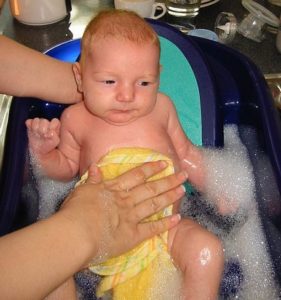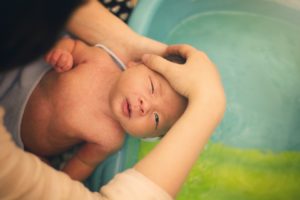Cleaning your baby
Your baby doesn’t need a tub bath every day, a couple of times a week is usually enough for most babies when they are young. On a daily basis you can use a warm, damp washcloth to gently wash your baby’s face (including their eyes and mouth), hands and bottom. When washing or bathing your baby always start with their eyes and face and then work your way down their body.
Your baby’s eyes
Your baby’s eyes may be swollen and have a little discharge after birth.
To care for your baby’s eyes
- Use a clean wet cloth to wipe from the inner corner to the outer corner of the eye.
- Use a different part of the cloth every time you wipe.
Your baby’s mouth
At birth, your baby’s first teeth are already underneath the gums. Taking care of your baby’s mouth and gums will help keep those baby teeth healthy. Gently wipe your baby’s gums with a clean, damp washcloth every day. Once teeth appear, a small baby toothbrush with a rice-sized amount of fluoride toothpaste can be used daily to clean your baby’s teeth. Lift your baby’s lip once a month to look for any signs of tooth decay. If you notice any signs of changes in your baby’s teeth, call your dentist or dental hygienist.
Bathing your baby
While some babies love bath time, others don’t. It can help to choose a time of day when your baby is in a quiet alert state and not hungry or tired. Talking calmly to your baby will reassure them that all is well. As your baby gets older bath time will usually be more enjoyable for them.

Bathing tips:
- You can bathe your baby in a baby tub, a clean kitchen or bathroom sink, a regular tub (with a parent in the tub with the baby) or an inexpensive plastic dishpan.
- Have everything you need within easy reach before you start to bath your baby. For example clean washcloths, a couple of towels, a clean diaper, clothing and any baby body wash/shampoo/soap you are using.
- If you are using soaps, shampoos and body wash , look for products that are mild or scent-free and that are hypoallergenic.
- It is helpful to open the caps on bottles of body wash/shampoo before starting the bath, or transfer to a reuseable pump top bottle.
- The temperature of the bath water should be comfortably warm. Check the temperature with your wrist or elbow.
- Do not use oil in the bath water as it will make your baby too slippery to handle safely. It is normal for a newborn to have peeling skin, especially on their hands, feet and head, it will usually go away without needing to use lotions, oils or creams.
- Undress your baby and wrap them in a towel, use a wash cloth to clean their face and eyes. Do not use a cotton-tipped applicator (for example, Q-Tips®) inside your baby’s ears as they can hurt the eardrum, gently wipe the outer ear using a wash cloth.
- Next hold them, still wrapped in the towel, over the tub and gently wet,clean and rinse their head/hair and then dry their head to prevent them from getting cold.

- Unwrap the baby and move them into the tub. To hold them securely, rest their head on your fore-arm and use the same hand to hold the baby’s upper arm. Use your other hand under their bottom to then lift them into the tub. It is helpful to continue supporting their head on your fore-arm and holding their arm as you use your other hand to clean them.
- Wash your baby’s hands and feet first and wash the bottom last.
- Lift the baby out of the tub onto a towel and pat dry, take care to get into all the creases.
- Avoid baby powder as it can cause choking and breathing difficulties for your baby.
- If your baby is feeling a little over-whelmed after the bath and is crying, skin-to-skin is a good way to calm them and warm them up.
Never leave your baby alone in the tub or near water, drowning can occur even with a shallow amount of water.